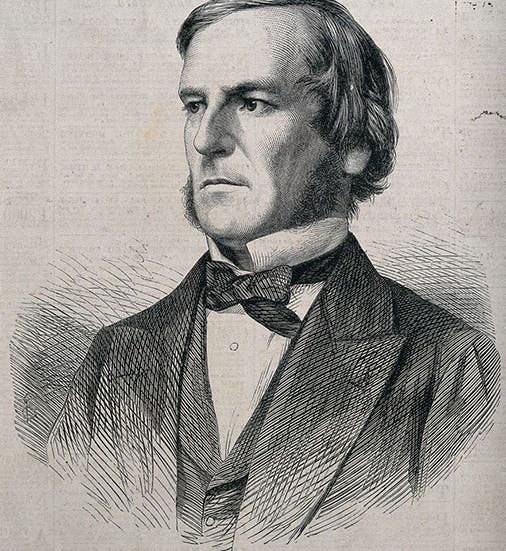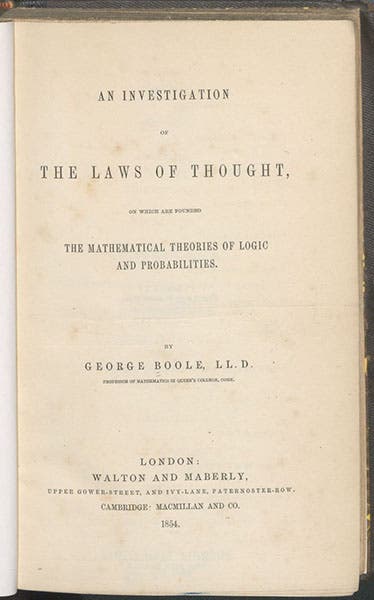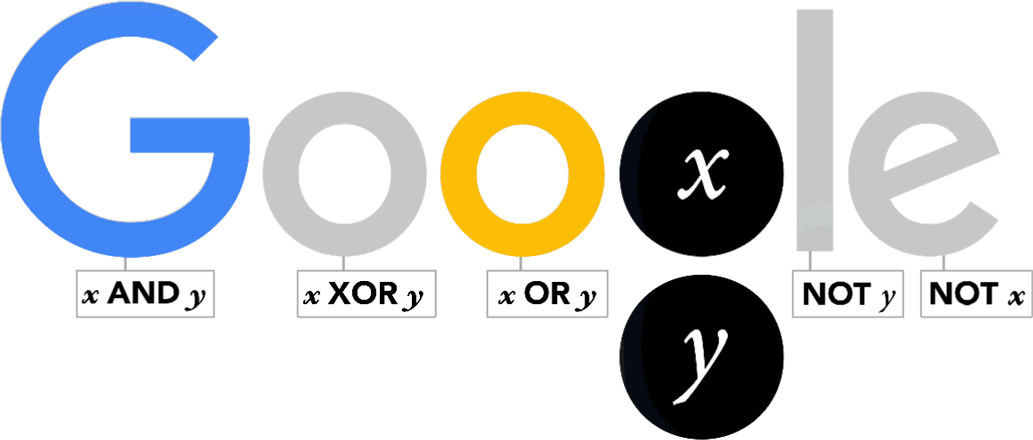Scientist of the Day - George Boole
George Boole, an English mathematician, was born Nov. 2, 1815, in Lincoln, Lincolnshire, in northeastern England. He was mostly self-taught, first in languages, then in mathematics. At the age of 16, he took on the support of his family (his father, a shoemaker, was still alive and with the family – I am not sure what the problem was), and George did so by teaching school, at first in towns some distance from Lincoln, and then closer and closer, eventually running his own school in Lincoln for 9 years. And he started writing math papers on topics related to algebraic equations. By a stroke of luck, a new journal had been founded in 1836, the Cambridge Mathematical Journal, edited by a Scotsman, Duncan Gregory, who was only 3 years older than Boole. The two young men hit it off; Gregory was impressed by Boole's work and was happy to publish his papers.
In 1843, Boole submitted a paper that was too long for the Cambridge journal, so Gregory suggested that he submit it to the Royal Society of London for their Philosophical Transactions. Amazingly, the paper was accepted and printed, as “A general method in analysis,” and not only was it printed, it was awarded the Royal Medal as the best math paper published in the journal in the past 3 years. It is hard to comprehend how, in the class-conscious Royal Society, the paper got accepted, how it won the medal, and how Boole managed to write it in the first place, with no university education in his background.
More astounding things were to happen. Queen's College, Cork (now University College, Cork), was looking to hire its first professor of mathematics in 1849. Boole applied, and with his publication record and the Royal Medal in his pocket, he outshone the other applicants and was hired. So there he was, a professor earning about £250 a year, with no academic credentials whatsoever. He married and began a family, and in 1854, he published his master work, Investigation of the Laws of Thought, an expansion on (and correction of) his earlier The Mathematical Analysis of Logic (1847). We do not own the first book, but we do have the second, which introduced Boolean logic to the world.
Boole had the idea of applying the tools of algebra to logic. In Boolean algebra, the variables are either 1 or 0 (on or off, yes or no), and the operators are And, Or, and Not. Applying algebra to logic allowed Boole to solve very sophisticated logical problems, the sort that gave me fits on LSAT-kinds of exams, such as: Bill, Sam, and Arthur work on a train; the engineer plays darts; Mr. Jones does not smoke, Sam is the brother of Mr. Robinson’s wife. Who is the brakeman? Boole provided a symbolic logic that allowed such problems to be solved.
When, much later, in 1938, a young engineer named Claude Shannon was looking for a way to design switching circuits for telephones, he happened upon Boolean algebra and found it to be the perfect tool to design what came to be called logic gates. Shannon went on to found information theory, with Boolean logic at its heart. Modern computer designers cannot do without it. (We wrote a post once on Shannon, but it was the beginning of the COVID scare in April of 2020, and it never got published. We will queue it up for Apr. 30 of 2024.)
Boole did well at Cork. As you can see from the title page of his 1854 book (third image), by the time it appeared, he had an honorary LL.D. (from either Oxford or Dublin). But tragedy struck in 1864; he got caught in a rainstorm, taught his class soaking wet, came down with pneumonia, and died, leaving a lot of “what ifs?” behind. He was 49 years old.
Boole was well-regarded by 19th-century mathematicians, but it wasn’t until Shannon’s work that he became truly famous (and the terms “Boolean algebra” and “Boolean logic” became part of the mathematical lexicon). He is esteemed at University College, Cork, where they honor him with a bronze bust in a courtyard (fourth image), and he is equally revered in Lincoln, where there is a plaque on the site of the school he ran (fifth image), and a recently installed (2023) statuary group at the Lincoln train station (which I do not show you because I am not fond of statuary groups, especially those that involve children; they invariably look like they were designed by Norman Rockwell). There is even a stained-glass window dedicated to Boole in Lincoln Cathedral.
Since I cannot really appreciate the genius of Boolean algebra, for me the most impressive aspect of Boole’s career is that it existed at all. Do you know how hard it is to teach yourself calculus from a textbook, one written in French to boot? And then to master differential and linear equations, with no one to provide guidance or answer questions? And then to do original work, and find a way to get it published, when you have absolutely no credentials? And then to get hired as a professor of mathematics, with no degree. Boole obviously had something going for him that does not come across in any of the biographies. He deserves great admiration from all of us.
Google honored Boole with an animated Doodle on his 200th birthday, Nov. 2, 2015 (sixth image).
William B. Ashworth, Jr., Consultant for the History of Science, Linda Hall Library and Associate Professor emeritus, Department of History, University of Missouri-Kansas City. Comments or corrections are welcome; please direct to ashworthw@umkc.edu.












